Emotional attachment to marketing content can influence potential customers. FOMO is a worth considering marketing prospect for businesses. Survival in a growing marketing verse is only possible by adapting new trends.
Fear of missing out on an important deal, subject, or event triggers humans to take quick action. Using it in social media, email marketing, and PPC campaigns can deliver high returns.
The demand for a diverse marketing approach is on the rise. Here are some FOMO statistics that can help you make informed decisions.
Top FOMO Statistics
what Is FOMO?
Fear of missing out is a psychological marketing technique that creates a sense of scarcity in buyers mind. Which influences their purchasing decision and increases the conversion rate. For example, if someone was 80% mentally prepared to buy a product, adding FOMO in your marketing campaign can turn into 100%.
General FOMO statistics
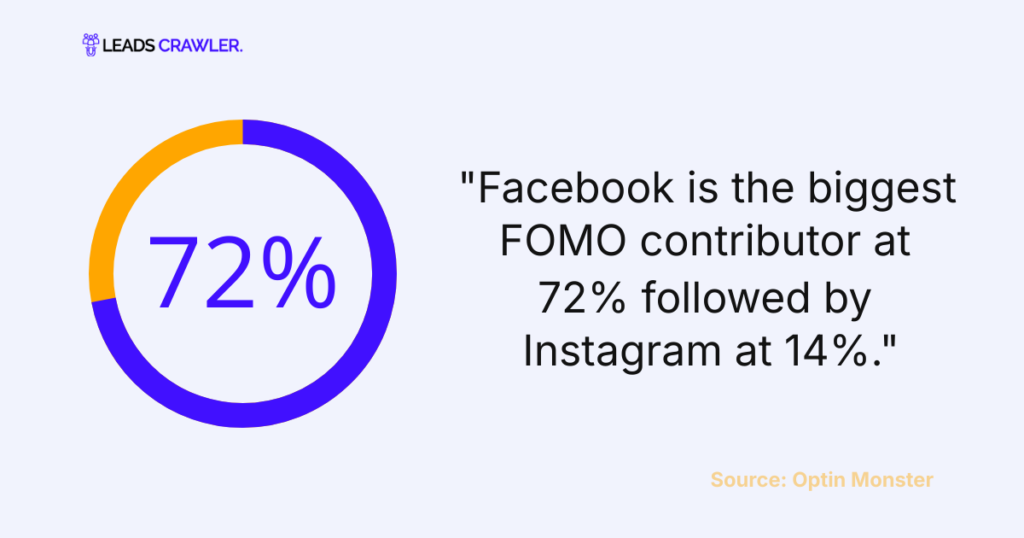
FOMO is a sense of anxiety that people feel in social, consumer, and professional contexts. The emergence of social media is considered the key reason behind it. Here are some general FOMO statistics you need to know.
- Facebook is the biggest FOMO contributor at 72% followed by Instagram at 14%. (Source: Optin Monster3)
- A study reveals more than 55% of teenagers from 15 to 18 experience FOMO. (Source: Annex Cloud)
- Female teens go through high levels of FOMO (51.28% ) as compared to male ones. (Source: Annex Cloud)
- 29% of people discover pleasure and happiness alongside FOMO. (Source: Optin Monster)
- Using FOMO in ad campaigns increases the CTR by 14%. (Source: Criteo)
- The inclusion of FOMO-generating strategies in user-generated content increases engagement by 28%. (Source: Comscore)
Also Read: 50+ Landing Page Statistics: Fresh Data With Sources
Marketing FOMO Statistics
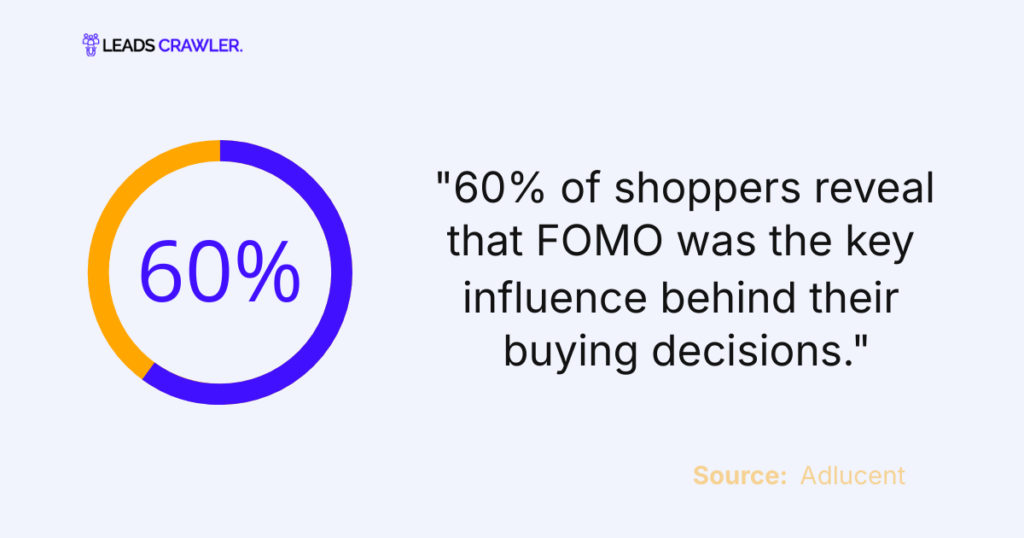
FOMO has a great influence on consumers and is used by various brands in their marketing strategies. Considering its importance here are some marketing FOMO statistics that can be helpful to scale your business.
- 47% of internet users believe FOMO during special events and occasions has a strong impact. (Source: Hootsuite4)
- 60% of shoppers reveal that FOMO was the key influence behind their buying decisions. (Source: Adlucent5)
- 41% of buyers claim that they are more likely to buy a product after 1 to 4 reviews due to the FOMO element. (Source: Optin Monster)
- 67% of travelers book their trips because of FOMO. (Source: Expedia)
- 63% of consumers prefer to purchase from a website that has reviews and positive ratings. (Source: Fortune Lords)
Millennials FOMO Statistics
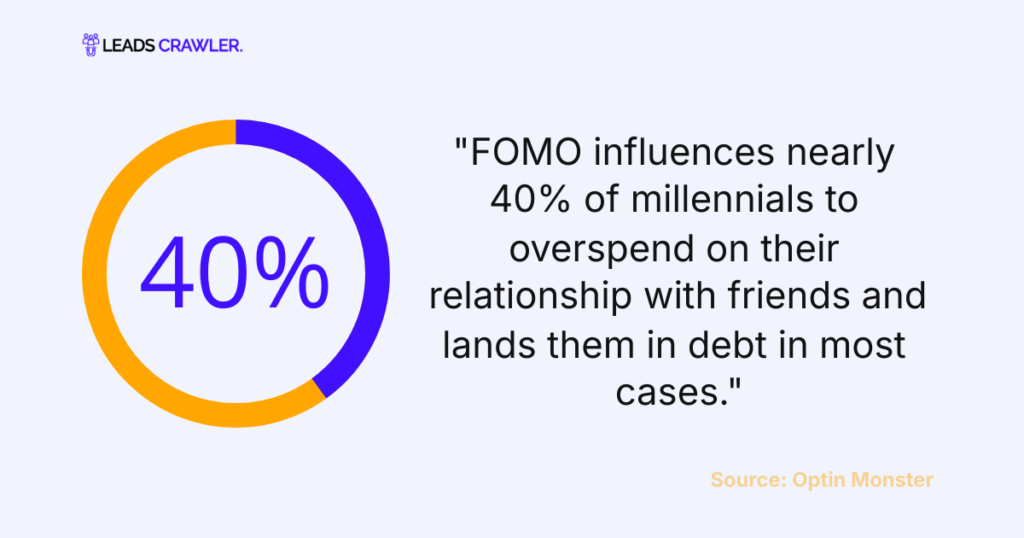
Millennials experience and report the influence of FOMO in their lives. From psychological impact to consumer behavior, its effects in different aspects are evident. These millennial FOMO statistics will further clarify this stance.
- FOMO influences nearly 40% of millennials to overspend on their relationship with friends and lands them in debt in most cases. (Source: Optin Monster)
- 60% of millennial consumers have revealed a decision in their reactive purchases after experiencing FOMO, most likely within 24 hours. (Source: Optin Monster)
- As per the research, 41% of millennials perform quick mobile transactions under the influence of FOMO. (Source: Fortune Lords)
- 48% of millennials spend unearned money to maintain relationships with their friends. (Source: Fortune Lords)
- Nearly 3 out of 4 millennials spend money on different experiences rather than materialistic things. (Source: Trust Pulse)
- 30% of millennials spend nearly 18 hours daily consuming different media sources. (Source: Optin Monster)
- As per research, 60% of millennials believe that UGC has more ability to expand their perspectives than traditional content. (Source: Skift)
- 50% of millennials attend events just to get something for online sharing. (Source: Trust Pulse)
- 45% of millennials accept their left-out feelings if they don’t participate on social media. (Source: Event Brite)
Also Read: 55 Content Marketing Statistics And Trends For 2024
Social Media FOMO Statistics
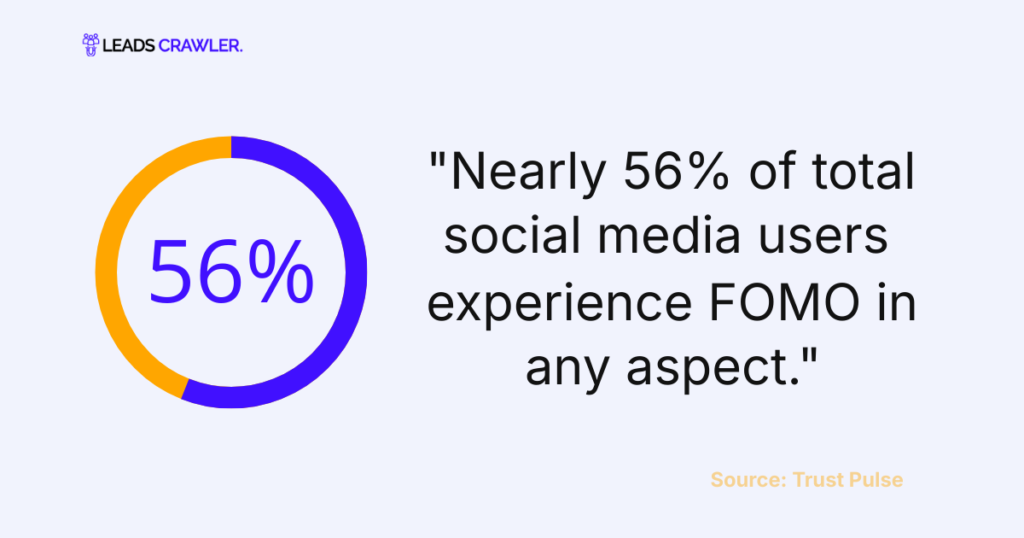
This unique phenomenon has been amplified after the rise of social media. It badly impacts mental health and source to generate social anxiety. Seeing the life experiences of others on social media triggers FOMO that leads to the feelings of envy. The below social media FOMO statistics further highlight its existence.
- Nearly 56% of total social media users experience FOMO in any aspect. (Source: Trust Pulse)
- Nearly 27% of people check their social media first thing once they wake up. (Source: Optin Monster)
- Nearly 26% of social media users feel afraid to lose their friends and 23% of being judged due to FOMO. (Source: Trust Pulse)
- 35% of users post content on social media to reduce FOMO effects on them. (Source: The Manifest)
- 60% of millennials love to share their life experiences on social media channels. (Source: Trust Pulse)
UGC FOMO Statistics
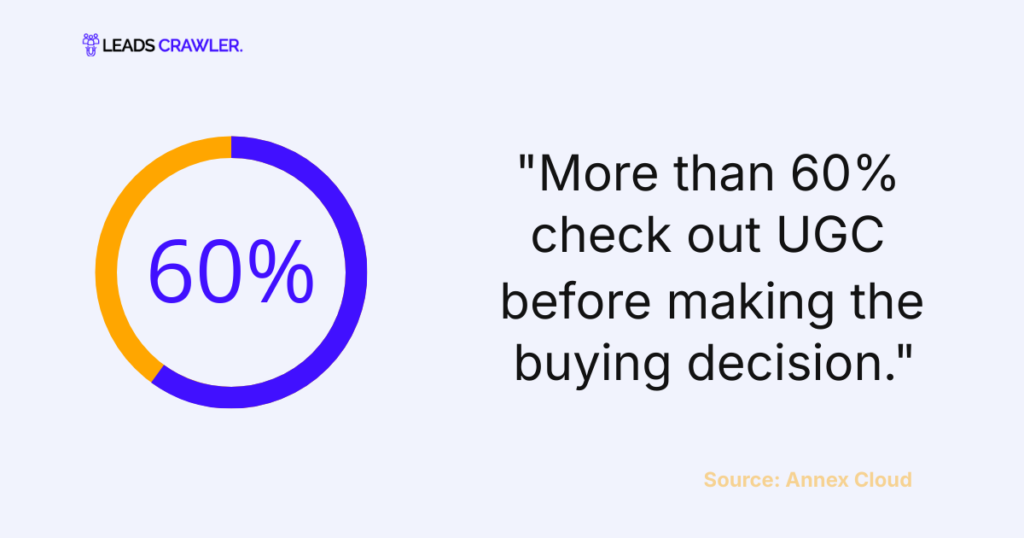
User-generated content improves consumers’ confidence in the product’s quality. It has a deep involvement in creating fear of missing out. Here are a few UGC FOMO statistics for better understanding.
- More than 60% check out UGC before making the buying decision. (Source: Annex Cloud)
- 48% of consumers consider user-generated content as a good resource to find new products for them. (Source: Optin Monster)
- Companies that integrated UGC into their websites enjoy 18% higher revenue. (Source: Annex Cloud)
- 84% of millennials claim the influence of UGC in their buying decisions. (Source: Optin Monster)
Also Read: 50+ B2B Marketing Statistics: Sales Metrics And Trends
Frequently Asked Questions
Wrap Up
FOMO is not just an unrealistic notion but an existing challenge. It can be useful from a marketing perspective but has serious health implications.
Businesses use a sense of scarcity and urgency to influence their consumers. The right use of this strategy can enhance the performance of a marketing campaign and generate more revenue.
Sources list:
- Source: Event Brite (https://eventbrite.com/blog/fomo-statistics/) ↩︎
- Source: Trust Pulse (https://www.trustpulse.com/fomo-statistics/) ↩︎
- Source: Optin Monster (https://optinmonster.com/fomo-statistics) ↩︎
- Source: Hootsuite (https://www.hootsuite.com/resources/social-media-statistics) ↩︎
- Source: Adlucent (https://adlucent.com/resources/blog/consumer-behavior-fomo-marketing) ↩︎